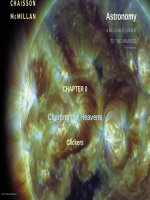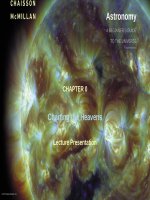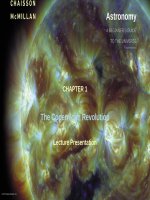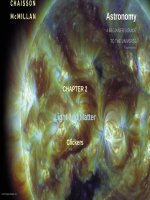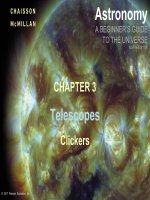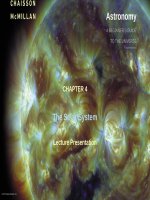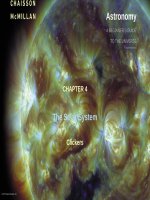Astronomy a beginners guide to the universe 8th CHaisson mcmillan chapter 13
Bạn đang xem bản rút gọn của tài liệu. Xem và tải ngay bản đầy đủ của tài liệu tại đây (3.85 MB, 40 trang )
Astronomy
A BEGINNER’S GUIDE
TO THE UNIVERSE
EIGHTH EDITION
CHAPTER 13
Neutron Stars and Black Holes
Lecture Presentation
© 2017 Pearson Education, Inc.
Chapter 13 Neutron Stars and Black Holes
© 2017 Pearson Education, Inc.
Units of Chapter 13
•
•
•
•
•
•
•
•
•
Neutron Stars
Pulsars
Neutron Star Binaries
Gamma-Ray Bursts
Black Holes
Einstein’s Theories of Relativity
Space Travel Near Black Holes
Observational Evidence for Black Holes
Summary of Chapter 13
© 2017 Pearson Education, Inc.
13.1 Neutron Stars
•
•
After a Type I supernova, little or nothing remains of the original star.
After a Type II supernova, part of the core may survive. It is very dense—as dense as an
atomic nucleus—and is called a neutron star.
© 2017 Pearson Education, Inc.
13.1 Neutron Stars
•
Neutron stars, although they have 1–3
solar masses, are so dense that they are
very small. This image shows a
1-solar-mass neutron star, about 10 km in
diameter, compared to Manhattan.
© 2017 Pearson Education, Inc.
13.1 Neutron Stars
•
Other important properties of neutron stars (beyond mass and size):
–
Rotation—As the parent star collapses, the neutron core spins very rapidly, conserving
angular momentum. Typical periods are fractions of a second.
–
Magnetic field—Again as a result of the collapse, the neutron star’s magnetic field becomes
enormously strong.
© 2017 Pearson Education, Inc.
13.2 Pulsars
•
The first pulsar was discovered in 1967. It emitted extraordinarily regular pulses; nothing
like it had ever been seen before.
•
After some initial confusion, it was realized that this was a neutron star, spinning very
rapidly.
© 2017 Pearson Education, Inc.
13.2 Pulsars
•
But why would a neutron
star flash on and off?
This figure illustrates the
lighthouse effect
responsible.
•
Strong jets of matter are
emitted at the magnetic
poles, as that is where they
can escape. If the rotation
axis is not the same as the magnetic
axis, the two beams will sweep out circular paths.
•
If Earth lies in one of those paths, we will see the star blinking on and off.
© 2017 Pearson Education, Inc.
13.2 Pulsars
•
Pulsars radiate their energy away quite rapidly; the radiation weakens and stops in a few
tens of millions of years, making the neutron star virtually undetectable.
•
Pulsars also will not be visible on Earth if their jets are not pointing our way.
© 2017 Pearson Education, Inc.
13.2 Pulsars
•
There is a pulsar at
the center of the
Crab Nebula; the
images to the right
show it in the “off”
and “on” positions.
© 2017 Pearson Education, Inc.
13.2 Pulsars
•
The Crab pulsar also pulses in the gamma-ray spectrum, as does the nearby Geminga
pulsar.
© 2017 Pearson Education, Inc.
13.2 Pulsars
•
An isolated neutron star has been observed by the Hubble telescope; it is moving rapidly,
has a surface temperature of 700,000 K, and is about 1 million years old.
© 2017 Pearson Education, Inc.
13.3 Neutron Star Binaries
•
Bursts of X-rays have
been observed near
the center of our
Galaxy. A typical one
appears at right, as
imaged in the X-ray
spectrum.
© 2017 Pearson Education, Inc.
13.3 Neutron Star Binaries
•
•
These X-ray bursts are thought to originate on neutron stars that have binary partners.
The process is very similar to a nova, but much more energy is emitted due to the
extremely strong gravitational field of the neutron star.
© 2017 Pearson Education, Inc.
13.3 Neutron Star Binaries
•
Most pulsars have periods between 0.03 and 0.3 seconds, but a new class of pulsar was
discovered in the early 1980s: the millisecond pulsar.
© 2017 Pearson Education, Inc.
13.3 Neutron Star Binaries
•
Millisecond pulsars are thought to be
“spun-up”
by matter falling in from a companion.
•
This globular cluster has been found to
have 108 separate X-ray sources, about
half of which are thought to be millisecond
pulsars.
© 2017 Pearson Education, Inc.
13.4 Gamma-Ray Bursts
•
Gamma-ray bursts also occur and were first spotted by satellites looking for violations of
nuclear test-ban treaties. This map of where the bursts have been observed shows no
“clumping” of bursts anywhere, particularly not within the Milky Way. Therefore, the bursts
must originate from outside our Galaxy.
© 2017 Pearson Education, Inc.
13.4 Gamma-Ray Bursts
•
These are some sample curves plotting
gamma-ray intensity versus time for gammaray bursts.
© 2017 Pearson Education, Inc.
13.4 Gamma-Ray Bursts
•
Distance measurements of some gamma bursts show them to be very far away—2 billion
parsecs for the first one measured.
•
Occasionally, the spectrum of a burst can be measured, allowing distance determination.
© 2017 Pearson Education, Inc.
13.4 Gamma-Ray Bursts
•
Two models—merging neutron stars or a hypernova—have been proposed as the source
of gamma-ray bursts.
© 2017 Pearson Education, Inc.
13.4 Gamma-Ray Bursts
•
This burst looks very
much like an
exceptionally strong
supernova, lending
credence to the
hypernova model.
© 2017 Pearson Education, Inc.
13.5 Black Holes
•
The mass of a neutron star cannot exceed about 3 solar masses. If a core remnant is
more massive than that, nothing will stop its collapse, and it will become smaller and
smaller and denser and denser.
•
Eventually, the gravitational force is so intense that even light cannot escape. The remnant
has become a black hole.
© 2017 Pearson Education, Inc.
13.5 Black Holes
•
The radius at which the escape speed from the black hole equals the speed of light is
called the Schwarzschild radius.
•
•
Earth’s Schwarzschild radius is about a centimeter; the Sun’s is about 3 km.
Once the black hole has collapsed, the Schwarzschild radius takes on another meaning: It
is the event horizon. Nothing within the event horizon can escape the black hole.
© 2017 Pearson Education, Inc.
13.6 Einstein’s Theories of Relativity
•
Special relativity:
1.
The speed of light is the maximum possible speed, and it is always measured to have the
same value by all observers.
© 2017 Pearson Education, Inc.
13.6 Einstein’s Theories of Relativity
2.
3.
© 2017 Pearson Education, Inc.
There is no absolute frame of reference and no absolute state of rest.
Space and time are not independent, but rather are unified as spacetime.
